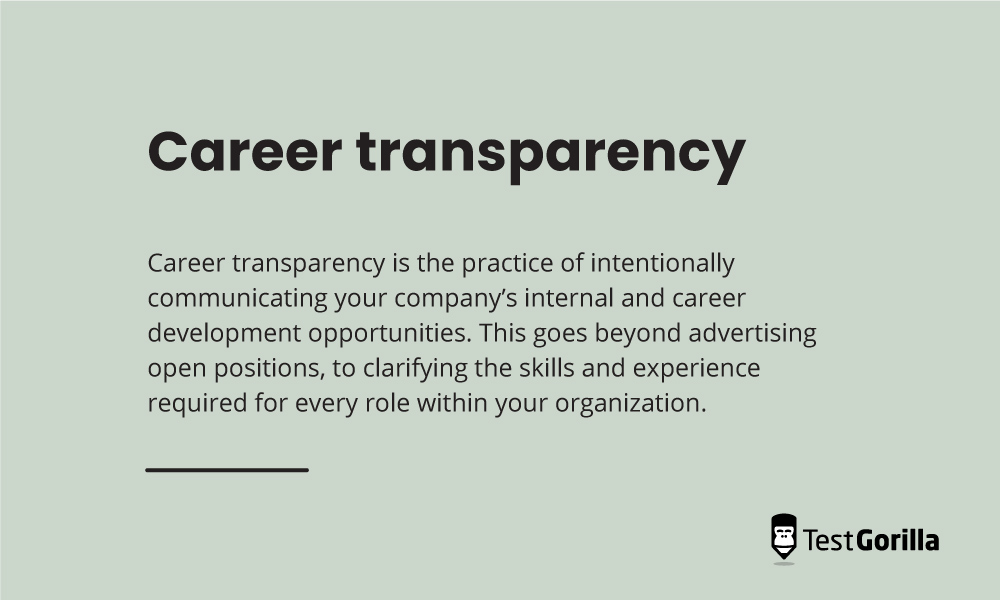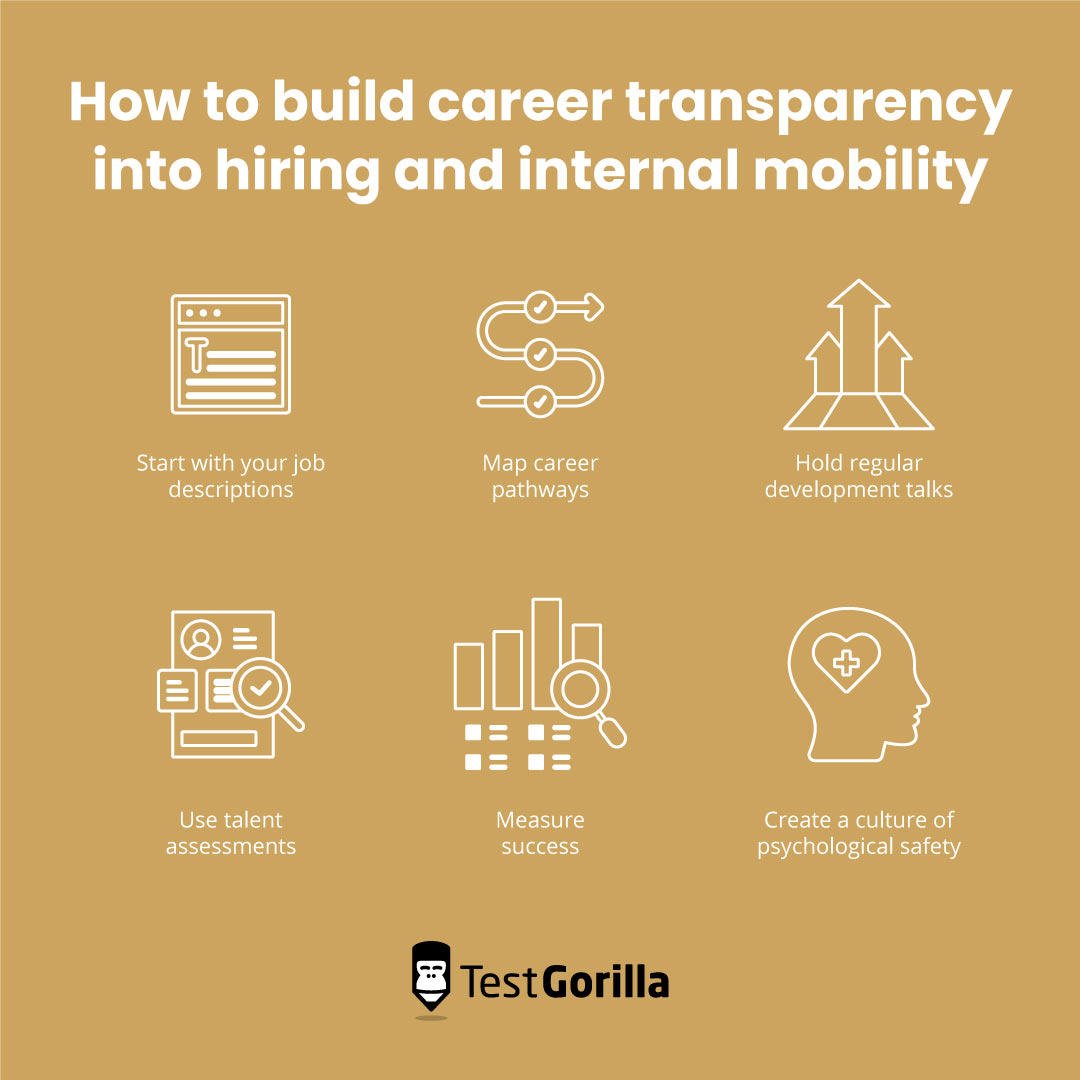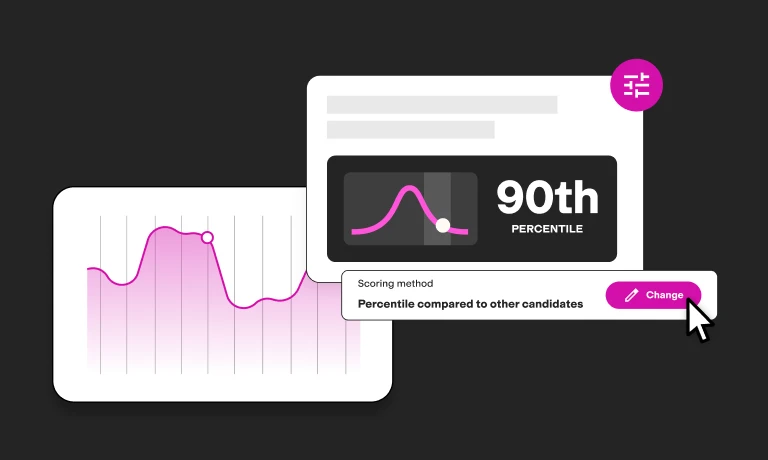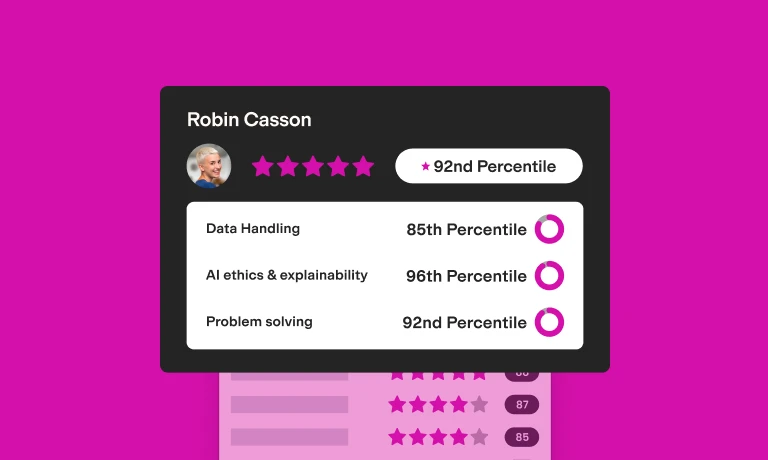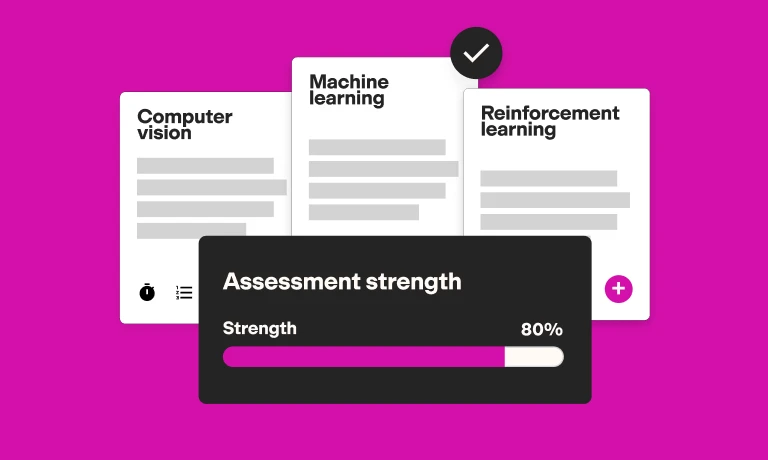While the demand for talent remains at an all-time high, job seekers maintain the upper hand.[1] They have their pick of opportunities and can look further afield for the roles with more potential if they’re not satisfied with their current position.
This is what’s known as a candidate’s market, and it means you have to go the extra mile to wow top candidates.
The challenge isn’t just getting employees through the door, though, it’s convincing them to stay. In certain sectors, many people are on the verge of leaving, with over half confessing to having a resignation letter already drafted.[2]
Although the main culprit is pay, a close runner-up is a lack of career opportunities. Sixty-three percent of workers are so dissatisfied with their progress at their current organization, they say they’d rather look for jobs elsewhere than pursue a promotion.
This means one of your best chances of attracting and retaining candidates is to shout from the rooftops about the career opportunities you offer – and leave them in no doubt about what the future within your company holds.
This article will discuss career transparency and why it matters, as well as outline the best ways to build extra transparency into your hiring and promotion processes. By the time you’re finished reading, you’ll be well-placed to start scooping up loyal top talent — and retaining it.
What is career transparency?
Career transparency is the practice of intentionally communicating your company’s internal and career development opportunities. This goes beyond advertising open positions, to clarifying the skills and experience required for every role within your organization.
Career transparency also means showing employees how they can advance professionally and helping them make fully informed career decisions. This can be a valuable weapon to help you win the talent war.
True transparency means being upfront with every member of your organization and beyond. This means everyone from management to internal employees and interviewees should have visibility over development opportunities.
To really take this practice to the extreme, you could conduct all your hiring and development processes in public, like open-source DevOps platform GitLab does.
Why you need to be upfront about career paths
The goal of career transparency is to match more candidates with the right roles, boost hiring and internal mobility, and retain talent longer. When you have fewer unfilled positions and can maximize ROI on hiring, theoretically, your company should be more productive and more profitable.
However, there’s much more to career transparency than this.
Career transparency not only benefits your organization but is also fundamental to its health. Employees crave fulfillment and want to advance in their careers. When businesses fail to meet this need, it can lead to the current situation in which 43% of employees feel like their career has come to a halt.[2]
When this happens, workers disconnect from their job and, when it’s a candidate’s market, it’s easier for competitors to lure them away. This can have a domino effect on company performance and finances.
“Companies spend thousands of dollars recruiting employees and then further investments on training and developing them. Losing employees and having to replace them is extremely costly and time-consuming, and can lead to catastrophic failures within the company due to loss of key talent.”
Career transparency can be so vital that it compensates for other areas where companies can’t meet workers’ needs. Jo says: “While salary is rated as one of the most important things to a new candidate coming into a company, most people, if they are happy in a job and see good career prospects, will not leave based on salary alone.”
When discussing how to attract the best candidates and prevent employees from leaving, it’s easy to fall into an “us versus them” mentality, focusing on the benefits to you as a recruiter.
Career transparency has major advantages for workers as well.
The main advantage is that changing jobs is a risk that doesn’t always pay off – 56% of employees who resigned over lack of opportunities even say they regretted their decision later.[4] So, if a company can show their workers how to advance, it serves everyone’s best interests.
Career transparency may also improve the employee experience at your business by boosting engagement levels and job satisfaction.
Additionally, when you clearly communicate about opportunities, you stand a chance of attracting more diverse candidates, which positively impacts business performance. By advertising opportunities and career paths openly rather than looking for candidates through your networks, you open those opportunities up to those who might not otherwise hear about them.
For all these reasons, it’s essential you overcommunicate about the career opportunities your company offers. It’s no longer enough to just have progression and make that information available. You should show employees the possibilities, help them understand them, and deliver on all your promises.
The best insights on HR and recruitment, delivered to your inbox.
Biweekly updates. No spam. Unsubscribe any time.
How to build career transparency into hiring and internal mobility
Career transparency calls for intensive, ongoing communication with candidates and employees.
Every company is different, so what this looks like will depend on your goals, processes, and the types of workers your industry attracts.
Here are some common approaches to boosting transparency that you can consider.
1. Start with your job descriptions
Often, the first information candidates and employees will receive about a position is the job description – so you need to make it count.
TalentBoard surveyed job candidates (internal and external) to discover what information they want before they apply for a position.[5] Here are the answers they gave ranked in order of demand:
The skills and experience required for the role
Details about the application process
Other positions that are currently available
Benefits
The salary range and compensation structure
Examples of career paths
A typical ‘day in the life’ of the role
The profile of the successful candidate
An overview of the recruitment process
A significant change from previous years is how details about salary and benefits have increased in importance, which shows pay transparency is critical from the word go.
External candidates also want to understand an organization’s values and mission to see if they align with their own goals. This is especially important for Gen Z – soon to become the largest demographic of workers – which prioritizes purpose over pay.
2. Map career pathways
Job descriptions give candidates details about the role they’ll start with and where they might end up, but not always how they’ll get there.
This is where career pathways come in. These are roadmaps through the company that show candidates how to move from one role to another. A simple example is how an internship can lead to a permanent position and then to management.
These paths can enable your entire team to visualize the structure of the organization and spot opportunities where they might not have before.
It’s worth noting that these are called paths, not ladders. That’s because not all candidates are interested in promotions – some want to make lateral career moves.
Technology like people enablement platforms (PEP) can help you plot different pathways and share them with workers. Jo says: “At AtlasJobs, we provide the ability for employees to easily explore opportunities using our mapping technology, and receive notifications when opportunities they are interested in become available.”
Despite the availability of this technology, many companies still don’t take advantage of it. Twenty-one percent of workers feel their career has stagnated due to a lack of development framework tools.
This means organizations who are willing to invest in tools like PEPs and create career pathways could find they’ve got an easy advantage over the competition.
3. Hold regular development talks
If a future role is the destination and career pathways are the map, what comes next is the directions.
Employees need guidance from managers in the form of regular one-on-ones. These help employees clarify their aims, align themselves with organizational goals, and get feedback on their progress. Regular talks can also help team members understand their career trajectories better.
Yet 26% of reports say they don’t talk about career progression enough with their managers.
Although the ideal frequency depends on your business, it’s best to hold talks on a quarterly basis. This leaves enough time for employees to work on points from the previous session but still get sufficient feedback and guidance.
The topics you cover depend on your business, but managers could take inspiration from the GROW model which stands for “goal, reality, options, will.”[6]
Here are some examples of GROW in action:
Goal: What areas of the company would you like to learn more about?
Reality: Which tasks have you tried related to this role?
Options: Who could you talk to that has experience with this role?
Will: What support will you need from me?
A side benefit of development talks is how it strengthens manager and employee relationships. Workers are more likely to feel like their company cares about their progress when they receive regular check-ins.
4. Use talent assessments
When there’s an open position, there’s usually more than one candidate up for consideration. This means organizations require a fair and transparent process for deciding who gets the role.
Otherwise, it doesn’t matter how many career opportunities you offer – unconscious bias will perpetuate the current situation where less than half of underrepresented groups have seats in the boardroom.[7]
When this happens, employees from these groups will continue to feel like your company’s promotion process is neither fair nor transparent.
Talent assessments can help you assess which candidate is most suitable for a role. These are standardized tests that measure skills, aptitude, and personality. Done correctly, they can help you ensure you’re hiring people with the right skills to perform well and succeed in the role, rather than relying on outdated, biased methods like resumes or connections.
You can also use talent assessments as part of assessing employees’ suitability for a new position. Based on the results, you can see what skills and training they require to proceed and then test their progress at regular intervals.
Given how many people want career development, skills development is an important factor in rewarding and retaining talent.
Additionally, our 2022 State of Skills-based Hiring report found organizations that use talent assessments saw a 97.5% increase in diversity.
5. Measure success
Once you’ve launched these initiatives, you need ways to assess their impact on your organization. “Career transparency” may be an abstract idea but there are various methods of getting actionable insights into the success of your projects.
For example, Jo says: “Average employee tenure is a leading indicator. Employee referrals is another one. Employees tend to only refer people if they are happy with their position and career options.”
You can also request feedback from candidates. For internal employees, this could be as simple as asking during your regular development talks. You can also conduct anonymous surveys to guarantee more candid and in-depth responses.
Indicators of success may also vary between businesses. For instance, turnover rates differ between industries and can fluctuate due to other factors in the labor market. It’s best not to rely on one positive result as a sign you’ve succeeded, but use a range of metrics and indicators.
6. Create a culture of psychological safety
Successful development talks and feedback sessions require workers to share their opinions. Employees need to be open about their career expectations and whether the company is meeting them. You also should gather candid feedback about your hiring and promotional processes so you can improve.
However, four in five workers say they don’t feel comfortable giving constructive criticism at work for fear of the negative repercussions.
For career transparency to translate into career progression, you need to promote psychological safety at your workplace. Here are a few tips on how to do this:
Embrace feedback
Actively listen
Avoid placing blame for problems
Don’t forget that being upfront with your team will also build trust and make it easier for them to speak up. This means your efforts to improve career transparency and psychological safety may create a positive feedback loop.
Career transparency: Your secret weapon to win the talent war
The combination of a tight labor market and increased occupational mobility can cost companies their best candidates. To sidestep this problem, get vocal about the career opportunities you can provide candidates and existing employees.
That means intensive, ongoing communication during every stage of the hiring and internal mobility process. To achieve this, you can employ strategies like mapping career pathways, holding development talks, and using talent assessments to detect and develop the necessary skills for a career move.
When you show employees there’s a future within your organization, they’ll strive toward it – so everybody wins.
Want to identify the skills your employees will need to progress? Talent assessments let you find the best candidates for open roles — and tell you who’s ready for more responsibility. Download the 2022 State of Skills-Based Hiring report to learn more
Sources
Gone for now, or gone for good? How to play the new talent game and win back workers” – McKinsey & Company, March, 2022. Accessed May 8, 2023 https://www.mckinsey.com/capabilities/people-and-organizational-performance/our-insights/gone-for-now-or-gone-for-good-how-to-play-the-new-talent-game-and-win-back-workers
“A Look Inside the Great Resignation” – Wisetail and Onepoll, January 2022. Accessed April 24, 2023. https://talker.news/2022/01/24/nearly-70-of-millennials-and-gen-z-would-rather-find-a-new-job-than-try-to-get-promoted/
“Top Findings from Lattice’s Career Progression Survey” – Lattice in partnership with Censuswide, September 2021. Accessed April 24, 2023. https://lattice.com/library/top-findings-from-lattices-career-progression-survey
“The Beamery Talent Index Seventh Edition: Pulse of the Workplace” – Beamery, February 2023. Accessed April 24, 2023. https://beamery.com/resources/whitepapers/beamery-talent-index-seventh-edition-pulse-of-the-workforce#main-content
“2022 Candidate Research CandE Research Report” – TalentBoard, January 2023. Accessed April 24, 2023. https://www.thetalentboard.org/benchmark-research/cande-research-reports/
“Excellence in coaching: The Industry Guide” – Graham Alexander et al, 2006. Accessed April 24, 2023. https://books.google.gr/books?id=NQTdmXA7Zc8C&pg=PA83&redir_esc=y#v=onepage&q&f=false
“Corporate Leadership by Race” – Investopedia, December 2022. Accessed April 24, 2023. https://www.investopedia.com/corporate-leadership-by-race-5114494.
You've scrolled this far
Why not try TestGorilla for free, and see what happens when you put skills first.


